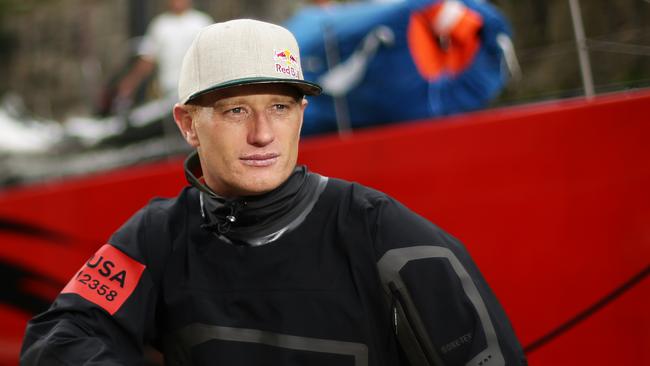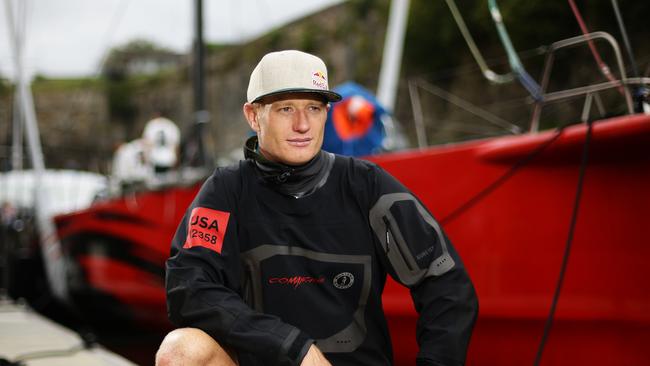Deadly 1998 Sydney to Hobart yacht race: America’s Cup hero James Spithill remembers his first trip south
He’s now one of the world’s best sailors but 25 years ago James Spithill was a scared teenager from a pretty Sydney suburb caught up in one of the worst maritime disasters in Australia.

NSW
Don't miss out on the headlines from NSW. Followed categories will be added to My News.
He’s now one of the greatest sailors in the world but 25 years ago James Spithill was a scared teenager from a quiet Sydney suburb caught up in one of the most deadly maritime disasters in Australia.
Spithill, who was making his Sydney to Hobart debut in 1998, now thinks it’s kind of strange he and US computer billionaire Larry Ellison, one of the richest men in the world who would later become both his boss and mate, were both caught up in the same deadly race and didn’t know each other.
A few years on they were connected at the hip with Spithill going on to steer two of Ellison’s America’s Cup campaigns in one of the most famous sporting events in the world – and famously pulling off one of sport’s great comebacks.
But in 1998, Spithill was just 19, an ambitious red-headed teenager still growing into his body and just starting to make a small indent on world sailing.
He was invited to do the Hobart by the late ocean racing veteran and multiple America’s Cup campaigner Syd Fischer and some of the best hands in the game and jumped at the chance.
In hindsight, the experience of that crew is probably what saved the kid from Sydney’s leafy northern beaches from being more damaged by the ordeal.

In contrast, Ellison, who said his maxi Sayonara “didn’t win the race, it survived it”, vowed he would never race it again – and hasn’t.
“Not if I live to be 1000,’’ Ellison said on his Hobart arrival where only 44 of the 115 starters docked that year.
While the devastating 1998 race, which claimed the lives of six sailors when a low exploded across the racecourse triggering horrendous and deadly conditions, hasn’t shaped Spithill’s life, as much as some, it has had an impact it something he still remember like yesterday.
“I was a first timer so it wasn’t the greatest introduction to ocean racing,” Spithill said in the lead-up to the 78th Sydney to Hobart, a race he will watch from the sidelines due to his international sailing commitments with the Italian America’s Cup team
“I was bringing up Christmas lunch the first night and thought it was bad then … it just got worse.’
“At 40 knots (74km/h) the motion was so uncomfortable because of the extremely violent slamming.
“At 60-70 knots (111-130km/h) the slamming stopped. We were just going up and down. It was still violent but a much bigger motions.’’
Many sailors post race spoke of a similar experience, describing it like being on a “rollercoaster from hell’’.


Spithill said he remembers best the noise of the cyclonic force winds bashing through the rigging and the darkness of the night.
“It’s one thing to be driving a boat in the day, you can help it through the water, he said.
“At night you can’t see anything. You are relying on instruments and feel.
“And that noise, that’s what I remember. At its peak it was unbelievable – the noise of the wind going through the rigging. It was eerie
“Then you’d get a breaking wave and you could hear it hitting the boat, hear it coming, I've never heard anything like that again.’’

Like Sayonara, Ragamuffin survived the 1998 race but six men did not – Mike Bannister, John Dean, Jim Lawler, Glyn Charles, Bruce Guy and Phil Skeggs.
In all 30 civil and military aircraft helped rescue 55 sailors, five yachts sank and seven were abandoned. Just 44 of the 115 starters made it to a sombre Hobart.
“I had heard what the reception is like for a boat in Hobart. I had race dinghies s there and couldn't wait for the arrival.
“But when we got there it was anything but a celebration
“It was sombre. News had got around and on out boat guys knew guys who were missing at sea.’’

Like many others Spithill has taken valuable lessons form being part of the race.
Safety has been increased across the board but for Spithill he learned the true value of a great team, something he believes has been instrumental in his success on the world sailing scene.
“Sailing is a challenge. For me that was the first time I had ever been sick. But I refused to let it stop me. I wanted to get back on the horse,’’ he said.
“I also learned from that race how important it is to have a good team around you and that mother nature is going to decide what’s happening, not you.
“Treating her with respect is a big part of ocean racing. With Mother Nature you have to be always aware of how quickly things can change.’’
Spithill, who is part of the Sydney to Hobart race day coverage this year, said he is always surprised how many people know of the 1998 tragedy.
“We (Larry Ellison) and I chat about it regularly. He was first, we were third and it was an experience we both shared with a lot of people. It does connect you.
“The thing that surprises me is how many people world wide know about this race.
“Still to this day will ask have you ever done that Sydney to Hobart and reference 1998.
“No one has forgotten.’’
Spithill has gone on to race and win numerous Sydney to Hobart’s but nothing compares to the 1998 event.
Spithill, the boy who grew up playing with little boats at Newport, is now involved in his sixth America’s Cup campaign at age is 44 after becoming the youngest Cup winning skipper at 30 and the youngest skipper to campaign an AC boat at just 20.
While he didn't have the time to campaign for Hobart this year, unlike others in the 1998 he will be back again, potentially as soon as next year.
“It’s a great race,’’ he said.
“I grew up on stories about it. It’s special.’’





